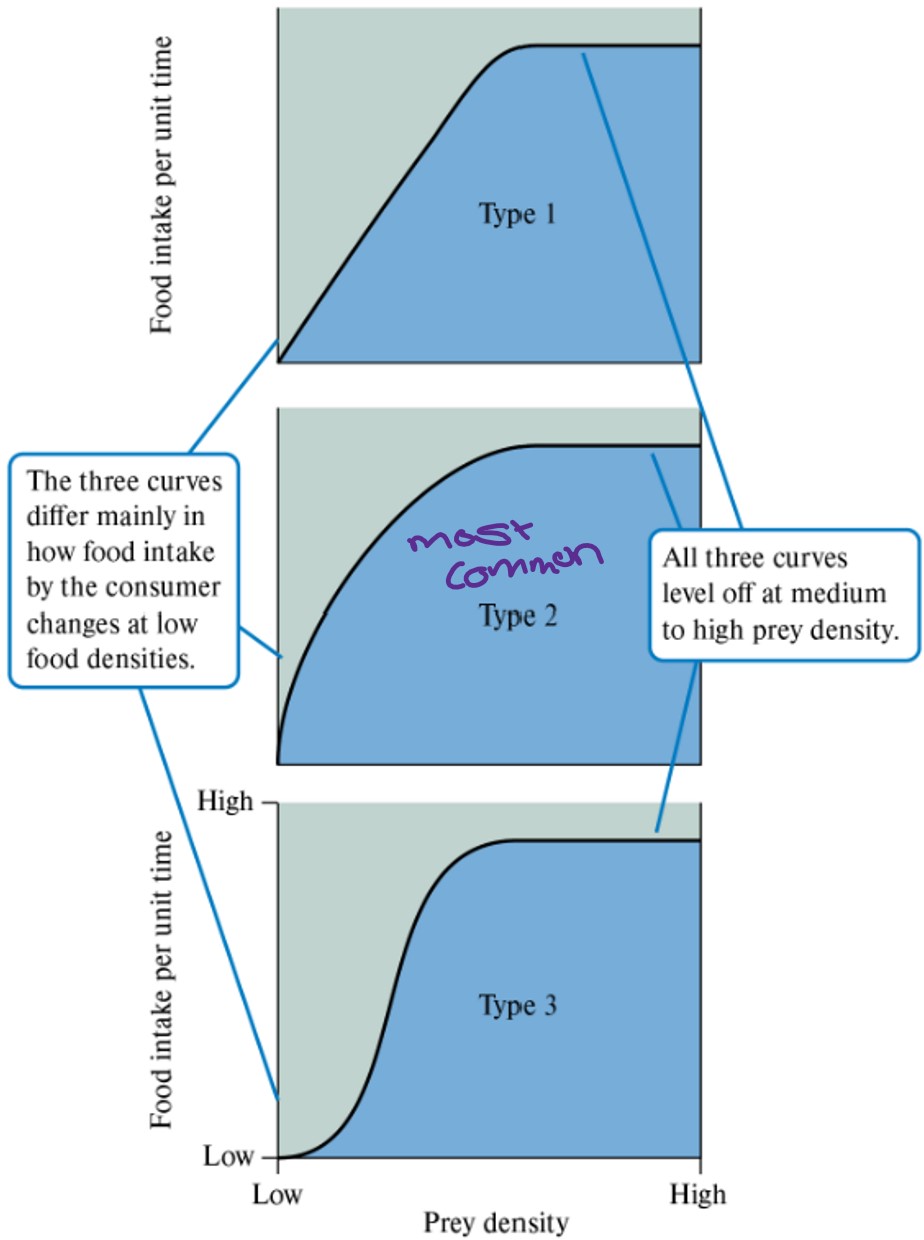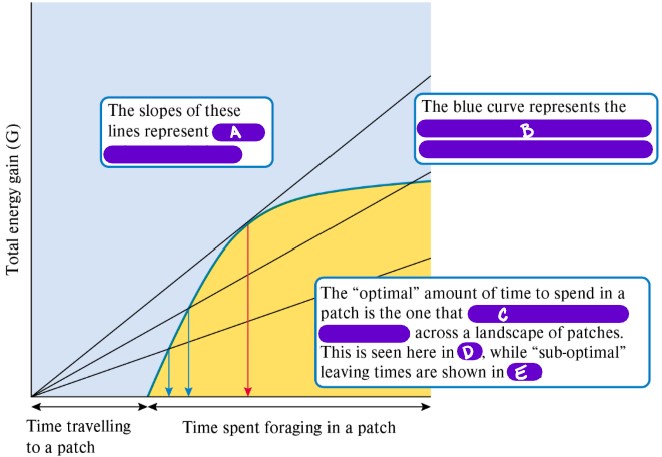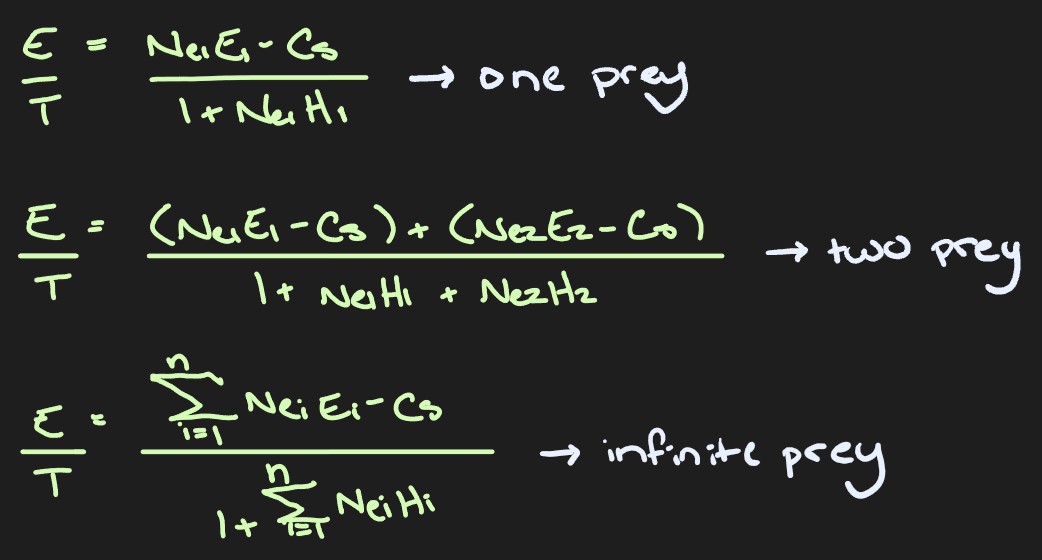10. Heterotrophs & Energy
0.0(0)
Card Sorting
1/30
Earn XP
Study Analytics
Name | Mastery | Learn | Test | Matching | Spaced |
|---|
No study sessions yet.
31 Terms
1
New cards
Herbivores vs Carnivores vs Detritivores
^^Herbivores^^ → organisms that **eat plants**
^^Carnivores^^ → organisms that **eat animals**
^^Detritivores^^ → organisms that **eat nonliving** (dead) **organic matter**
^^Carnivores^^ → organisms that **eat animals**
^^Detritivores^^ → organisms that **eat nonliving** (dead) **organic matter**
2
New cards
Food Economics Scale
Need to balance **ease** of getting food (**E used**) & food **quality** (**E gained**)
Scale w an **inverse relationship** → inc. ease = dec. quality (& vice versa)
Scale w an **inverse relationship** → inc. ease = dec. quality (& vice versa)
3
New cards
Define: Ecological Stoichiometry
**Balance** of multiple **chemical** elements in **ecological interactions**
Eg. trophic levels
Eg. trophic levels
4
New cards
Ecological Stoichiometry:
Relative Abundance of Carbon & Nitrogen (C:N ratio)
Relative Abundance of Carbon & Nitrogen (C:N ratio)
**Varies** → dictates what/how each time of heterotroph eats
\
^^Plants^^ → **high C:N** → lots of C used to build up structure
^^Animals, fungi, bacteria^^ → **low C:N** → less C needed
\
^^Plants^^ → **high C:N** → lots of C used to build up structure
^^Animals, fungi, bacteria^^ → **low C:N** → less C needed
5
New cards
What are the five elements that primarily make up biomass?
How does each contribute?
How does each contribute?
^^Carbon^^ → provides **structure** to organisms → major building block of all living things
^^Oxygen^^ → part of **water** molecules
^^Hydrogen^^ → part of **water** molecules
^^Nitrogen^^ → part of **amino** & **nucleic acids**
^^Phosphorus^^ → essential for **cellular processes** → ex. ATP E transfer
^^Oxygen^^ → part of **water** molecules
^^Hydrogen^^ → part of **water** molecules
^^Nitrogen^^ → part of **amino** & **nucleic acids**
^^Phosphorus^^ → essential for **cellular processes** → ex. ATP E transfer
6
New cards
Herbivory:
Economic Tradeoff
Economic Tradeoff
**High** ease (E used) → **lower** quality (E gained)
B/c **high C** & **low N**
B/c **high C** & **low N**
7
New cards
Herbivory:
Nutritional Chemistry & Plant Defense Challenges
(4)
Nutritional Chemistry & Plant Defense Challenges
(4)
**Low [N]** but high \[C\] → **low nutrient** content
**Cellulose** & **lignin** → strengthen plant tissues but inc. C:N & are difficult to ingest/digest → need adaptations to consume
\
Plant **physical** (eg. spines, thorns) &/or **chemical** (eg. toxins) **defenses** to overcome in order to consume
**Cellulose** & **lignin** → strengthen plant tissues but inc. C:N & are difficult to ingest/digest → need adaptations to consume
\
Plant **physical** (eg. spines, thorns) &/or **chemical** (eg. toxins) **defenses** to overcome in order to consume
8
New cards
Herbivory:
Ease of Acquiring & Quality of Food
Type of Adaptation Common to Herbivores
Ease of Acquiring & Quality of Food
Type of Adaptation Common to Herbivores
^^Ease^^ → generally **easy to find** & less competition
^^Quality^^ → plants are **poor food** → animals must **consume large amounts** to satisfy
\
Adaptations → **digestive**
^^Quality^^ → plants are **poor food** → animals must **consume large amounts** to satisfy
\
Adaptations → **digestive**
9
New cards
Carnivory:
Economic Tradeoff
Economic Tradeoff
**Low** ease (E used) → **higher** quality (E gained)
**Higher** energetic **cost**/harder to obtain but is **nutrient rich**
**Higher** energetic **cost**/harder to obtain but is **nutrient rich**
10
New cards
Carnivory:
Economic Stoichiometry Among Prey & Impact on Predator
Economic Stoichiometry Among Prey & Impact on Predator
Relatively **constant C:N** ration across animals species → **many prey** species available to predators b/c all nutritionally similar → can have a more **varied diet**
11
New cards
Carnivory:
Action of Selection & Type of Adaptation
Action of Selection & Type of Adaptation
Selection is **stronger** on the **ability** & **efficiency** of **capturing/consuming** diff preys → weaker on nutritional requirements
Adaptation → help them to **hunt effectively**
Adaptation → help them to **hunt effectively**
12
New cards
Detritivores vs Decomposers
^^Both^^ → contribute to decomposition → play essential role in **nutrient cycling**/recycling
\
^^Detritivores^^ → must **ingest** & **digest** dead organic matter via **internal** processes
^^Decomposers^^ → can **directly abs.** nutrients through **chemical** & **biological** processes
\
^^Detritivores^^ → must **ingest** & **digest** dead organic matter via **internal** processes
^^Decomposers^^ → can **directly abs.** nutrients through **chemical** & **biological** processes
13
New cards
Detritivory:
Economic Tradeoff
Economic Tradeoff
**High** ease (E used) → **higher/lower** quality (E gained)
Easily available but most nutrients have already been abs or lost
Easily available but most nutrients have already been abs or lost
14
New cards
Detritivory:
Ecological Stoichiometry of Most Dominant Food Source
Ecological Stoichiometry of Most Dominant Food Source
Food source → **dead plant material**
Are **rich** in **carbon** & **energy**, but are **poor** in **nitrogen** →
N is often limiting in live plants so there’s a selection for inc. N Use Efficiency which **reabsorbs N before** dropping leaves → now **even less N** for detritivores
Are **rich** in **carbon** & **energy**, but are **poor** in **nitrogen** →
N is often limiting in live plants so there’s a selection for inc. N Use Efficiency which **reabsorbs N before** dropping leaves → now **even less N** for detritivores
15
New cards
Detritivory:
Limitations
Limitations
^^Not limited^^ by **food** → relatively **high abundance** of dead plants in most communities
^^Limiting factors^^ → **abiotic** factors & **chemical composition** of food have more direct impacts
^^Limiting factors^^ → **abiotic** factors & **chemical composition** of food have more direct impacts
16
New cards
Omnivores vs Mixotrophs
Some organisms exploit **more than one** carbon source.
^^Omnivores^^ → gain E from both **plant** & **animal** matter
^^Mixotrophs^^ → can gain E from **photosynthesis** (inorganic) & from **consuming** organic materials
^^Omnivores^^ → gain E from both **plant** & **animal** matter
^^Mixotrophs^^ → can gain E from **photosynthesis** (inorganic) & from **consuming** organic materials
17
New cards
What are the heterotrophic plants?
(2)
(2)
^^Saprophyte^^ → obtain **food** from **dead matter** → lack chlorophyll → no photosynthesis → heterotroph
\
^^Parasites^^ → obtain **food** from **living plant host** → poor in chlorophyll → limited photosynthesis → most nutrients from the host → heterotroph
\
^^Parasites^^ → obtain **food** from **living plant host** → poor in chlorophyll → limited photosynthesis → most nutrients from the host → heterotroph
18
New cards
Plants that appear heterotrophic but aren’t
(2)
(2)
^^Epiphytes^^ → grow on other plants but **don’t parasitize** them
\
^^Insectivorous plants^^ → obtain **additional** nutrients from **trapped insects** → prefer photosynthesis but will eat insects → are **mixotrophs**
\
^^Insectivorous plants^^ → obtain **additional** nutrients from **trapped insects** → prefer photosynthesis but will eat insects → are **mixotrophs**
19
New cards
Define: Functional Response
The **relationship** b/w **food availability** (density) & **feeding rate** (intake)
\
**Inc.** in **feeding** rate → eventually **levels off** in response to an **inc.** in food **availability**
\
**Inc.** in **feeding** rate → eventually **levels off** in response to an **inc.** in food **availability**
20
New cards
Factors Influencing Feeding Rate
(5)
(5)
1. How much can **physically fit** in their mouth
2. **Time** to **digest** food → room for more
3. **Time** to **find** food
4. **Time** to **handle/process** food
5. Sometimes it’s **safer to hide** than to eat
21
New cards
What is displayed on functional response curves?
What is ILC on these graphs?
What is ILC on these graphs?
**Food intake** x **time to look for food**
^^ILC^^ → incipient limiting concentration → **prey density** at which **food intake** **levels** off into **asymptote**
^^ILC^^ → incipient limiting concentration → **prey density** at which **food intake** **levels** off into **asymptote**

22
New cards
Type I Functional Response Curves
(3)
(3)
Feeding rate **inc. linearly** (b/c of quick food processing) up to an **ILC**
At ILC → feeding rates **level off abruptly** → reaches its **max feeding rate**
Only animals requiring little/no time to process food have curves like this → eg. filter feeder
At ILC → feeding rates **level off abruptly** → reaches its **max feeding rate**
Only animals requiring little/no time to process food have curves like this → eg. filter feeder
23
New cards
Type II Functional Response Curves
(3)
(3)
Feeding rate **inc. linearly** at **low** conc. → **slower** rate at **moderate** conc. → then **levels** off at **high** conc.
\
Limited by **food search** at **lower** densities
Limited by **processing** & **digestion** at **higher** densities → food is widely available
\
Limited by **food search** at **lower** densities
Limited by **processing** & **digestion** at **higher** densities → food is widely available
24
New cards
Type III Functional Response Curves
(2)
(2)
Feeding rates are ^^S-shaped^^ → **low** at **low** densities → **inc.** greatly at **intermediate** densities → then **levels** off at **high** food densities
Can sometimes be seen when → food is better protected, uncommon food is ignored, inexperience hunting it, or starving animals
Can sometimes be seen when → food is better protected, uncommon food is ignored, inexperience hunting it, or starving animals
25
New cards
Optimal Foraging Theory
(4)
(4)
Describes how organisms feed as an **optimizing process** → by **maximizing** or **minimizing** some factors
Attempts to explain __what/when/where__ animals will eat
\
Assumes that if **E supplies** are **limited** → organisms **can’t max all** of its life fxns at once → must **allocate** E
**Cost/benefit** of allocating E to feeding
Attempts to explain __what/when/where__ animals will eat
\
Assumes that if **E supplies** are **limited** → organisms **can’t max all** of its life fxns at once → must **allocate** E
**Cost/benefit** of allocating E to feeding
26
New cards
Marginal Value Theorem
(2)
(2)
Describes the **optimal time** for a forager to **move** from one food patch to a **new location**
\
First reaches patch → consumption rates at **max** b/c there will be lots of food remaining
As food consumed → rate of intake **slows** b/c longer to find remaining food
\
First reaches patch → consumption rates at **max** b/c there will be lots of food remaining
As food consumed → rate of intake **slows** b/c longer to find remaining food
27
New cards
What does the optimal time to leave depend on in marginal value theorem?
(3)
(3)
1. **Time** to **move** to a new patch
2. **Qualities** of a patch
3. Aspects of the **foraging environment**
28
New cards

A → energy gain per unit time
B → total energy gained by an organism as it forages in a patch
\
C → **maximizes energy** gain **per** unit of **time**
D → red
E → blue
B → total energy gained by an organism as it forages in a patch
\
C → **maximizes energy** gain **per** unit of **time**
D → red
E → blue
29
New cards

Interpret Formula for Energy Intake of Predators
^^E^^ → energy
^^T^^ → time
^^Ne1^^ → number of prey encountered /unit time
^^Cs^^ → energy expended (cost) searching for prey
^^H1^^ → handling time
^^T^^ → time
^^Ne1^^ → number of prey encountered /unit time
^^Cs^^ → energy expended (cost) searching for prey
^^H1^^ → handling time
30
New cards
Diet Composition:
\
How does the energy intake equation predict how many prey species a predator will prey on?
\
How does the energy intake equation predict how many prey species a predator will prey on?
Whichever (E/T) is greater will be favoured
\
**One** prey species if → eq. **one** prey **>** eq. **two** prey
**Two** prey species if → eq. **one** prey **
\
**One** prey species if → eq. **one** prey **>** eq. **two** prey
**Two** prey species if → eq. **one** prey **
31
New cards

